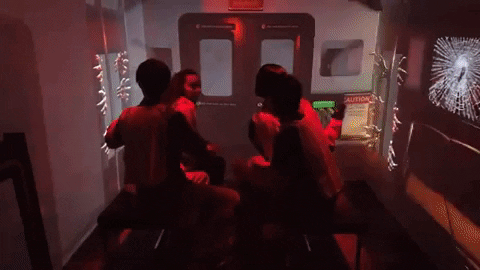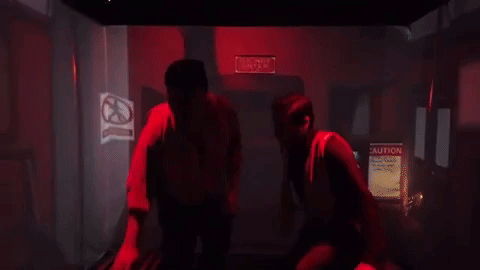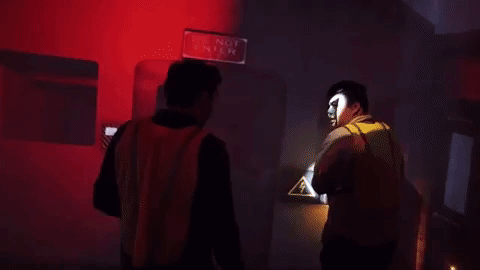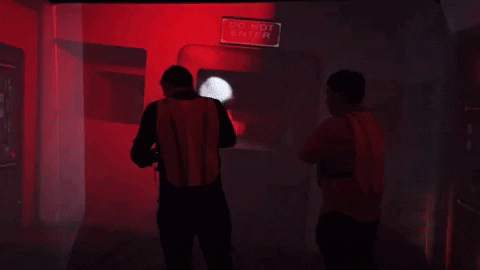Brandon Badger
Game Designer
Commute
Role: Sound Designer, Experience Designer
Team Size: 5
Project Duration: 3 weeks
An atmospheric theatrical horror escape room sequence set in a crashed subway. The guest has to reach to front car to reset the power while keeping monsters at bay. Created during my Building Virtual Worlds Course at Carnegie Mellon. It is a cross-disciplinary course where teams consisting of two programmers, two artists, and one sound designer create a virtual world in 1-2 weeks. We are given a specific prompt for each round that dictates the type of experience we will make. For instance, one round may be a story round while another focuses on the guest's feeling of freedom in the experience. The course is designed to teach cross-disciplinary collaboration to prepare students for industry development.
Abstract
What Went Well
- Introducing mechanics slowly as the experience goes on, while combining both with more difficulty at the end made for a very satisfying interest curve!
- The ambient sounds in combination with the realistic visuals really sold the space to our guests.
- Relying on sounds more than visuals due to time restraints worked very well! Making the monster sound real without actually showing the whole monster still made the guests frightened.
What Did Not Go Well
- The balance between the experience being engaging while making it easy enough for guests to never notice that there is no lose state was hard to accomplish.;;;;;;;;
Lessons Learned
- Using sound and visuals to increase tension/fear can be rather easy if you are aware of common horror tropes.
- I learned a rudimentary flow of introducing individual mechanics, to then combine them later. This gameplay/experience loop can lead to a satisfying experience for the guest!
Postmortem
Introduction & Overview
Round 4 of Building Virtual Worlds was an extremely fun experience for me as it encompassed one of my favorite aspects of interactive games: story! Our prompt for Round 4 was as follows:
Tell a compelling, meaningful interactive story where the guest has some ability to interact to bring the story to a fulfilling climax.
We were told to pay attention to the fact that they say to create an interactive story, not necessarily a branching story. It could be tempting to create a branching story to make it feel more interactive, but branching stories have to be equally strong no matter the ending that the guest experiences. Hence, all endings must be equally satisfying. The class and professors would only experience the world once, so branching narratives would almost be a waste of time and resources for this assignment.
We were given a lecture on story stack to inform us of the best practices for creating stories in media. The story stack goes as follows, from most flexible to least flexible:
Story: What is the narrative of the experience that makes sense in the world?
World: How does everything work in the world? Rules, relations, populations, etc? Meant to justify everything else below.
Economy: Any game that has some sort of progression has an “economy” of sorts, not only trading/bartering.
Action: What actions does the guest want to do in the fantasy?
Fantasy: What does the guest want to do in the experience?
We were taught that although the story itself is what people traditionally think is the most important to nail, it is the easiest to change. Our professors argued that it may be best to start with the fantasy, figuring out what exactly a guest in your world would want to do in the experience. They told us to keep the story stack in mind when designing this round, and all future projects.
The platform my team received was the CAVE, a room in our building that is unique to the Entertainment Technology Center. The room has three projection screens that surround a moving platform in the center. The platform can move each of the four corners up and down to varying degrees. The platform can also move its entire surface up and down along with the four corners. A few limitations of it are that you cannot move the platform very fast, and it is extremely loud when moving.

The CAVE room in the building.
Ideation & Brainstorming
Upon meeting up in our group to brainstorm ideas, we decided that the platform could work well as some sort of vehicle simulator. Having the guests sit or stand on the platform with the projection screens showing a moving world would work well! After agreeing upon the idea of vehicles, we then began to throw out ideas on what the setting could be. It was then that a teammate of mine pitched the idea that we could do a subway simulator where the guest sits down and experiences the feeling of being on a subway. We all immediately clung to the idea because the loudness/shakiness of the platform could work in our favor since subways are loud vehicles in reality. It seemed to be the perfect setting! It was then that I asked the team, “What if the subway crashes in the experience? What if the guest had to find a way to turn it back on?” This sparked the idea that we stuck with for the project, a horror subway escape room experience.
In hindsight, it seemed like we started with the fantasy of being on a vehicle in the cave, then immediately moved to the world with choosing the subway. We then snuck in a bit of story with the subway crashing for some reason, with the guest having to get the subway running again. When we were sold on that idea, we then changed the fantasy to surviving in a traditional horror setting in order to match the world and story we came up with. We believe that it is very interesting that we ended up changing the less flexible story stack element to keep the more flexible ones.
We decided that a three-room subway escape room would work well and allow us to easily build an interest curve for the guest. The first room would be immersing the player into the world with little interaction. The second room could introduce horror, and make the guest interact more with the space. The final room could really ramp up the fear factor while making the guest perform more difficult tasks to create as much tension and stress in them as possible.
Initial Vision
We first began to create the atmosphere of a subway by building models and creating sounds that matched the subway aesthetic. We knew that we had to nail the atmosphere because we believed that this experience would succeed or fail completely based on the guest’s immersion. The artist created the models for the subway, I created subway soundscapes, and the programmers implemented subway movement in sync with the platform and the lighting system.We thought that since this experience is more of an interactive theater than a game, why don’t we just set events as a keypress instead of timing? Then, the person at the computer could trigger events when the guest is ready to experience said event. This is much easier than hoping that the guest follows the exact timed sequence we would make for them.
We then decided that it would be best to just focus on the first room to make sure we could present the atmosphere, and explain what we were planning to do for the rest of the experience. So, we decided to completely focus on building the base for the world, and focus on the actual interactions and horror for later. We wanted to keep the actual interactions of the guest at a minimum in the first room to allow them to really take in the world, so we decided to simply have them use a keycard to open the door to the next room.
For our interim build, we built the first room of the subway, where the guest is brought into the space of a subway car about to leave. The subway begins to move when the guest decides to sit down, raising the front of the platform to portray acceleration. The guest then sits on the moving subway for a short time, making small talk with the actors riding if they choose to. The subway hits an object on the tracks, causing the camera and the platform to shake. The subway then slows down to a stop while the electricity flickers on and off. When the subway comes to a complete stop, the normal lights turn off to be replaced with red emergency lights. We throw in a very foreboding ambient soundscape to create unease in the guest. The two actors sit with the guest then prompt them to get up to start exploring for a way to get out. The guest then spots the unconscious body of a subway worker who was standing at the time of the crash. The guest retrieves a flashlight and keycard from the worker and is prompted to look for a way out. The two actors “try” to open the side doors to no avail, and the guest spots the door at the end of the car that leads to the next car. They then have to press the keycard against for the screen to open the door. Upon the door opening, the screen then fades to black. After a few seconds of complete silence, a harsh scream is played and bloody claw marks appear on the screen as an actor falls down to the ground.
Interim Feedback
The feedback we received from interim was almost exclusively positive! People loved the subway aesthetic and believed that it worked beautifully with the CAVE. The constructive feedback we received can be summarized to:
-
Having an unconscious body in the first car can lead to trouble when moving cars.
-
The high number of actors (3) feels a bit crowded.
-
The death of the actor at the end of the first car is a bit confusing, and the story still needs to be told.
Overall, we got very positive feedback, with the constructive feedback consisting mostly of minor tweaks and changes to our current build.
Second Interim Changes
First things first, we wanted to address the feedback we received from interim before moving on to the other cars. We knew before interim that the first piece of feedback was going to be an issue for us as we were having trouble placing the body at a location that is easy to spot while also being easy to move when they move cars. However, even if the body is in an area where they could easily crawl out, we would still have to hope that the guest would not turn around while they were moving. If they would see them moving out of the scene, their immersion would almost certainly be broken. So, we sat down to discuss what purpose the body has in terms of mechanics. We have that actor be a worker who has a flashlight to look around with and a keycard that allows access to the other cars. We were basically using them as a reason that the guest could find a keycard and flashlight on a subway. So, why not just make the guest the worker instead of a random actor? The only issue with this idea was that the guest may not understand that they are a worker, and what that means for them in the world. The solution we came up with to fix this is to make another actor a worker with the guest. They could then inform the guest about what objects they have with them, and what actions they were able to do. This change also fixes the second issue by getting rid of the unconscious actor.
The third issue was something we were anticipating as we knew we did not have all of the story beats in our build, and we only added the death of the one actor at the end just to have some type of ending for the interim. In terms of what we built for the second and third cars, we explored the previous idea of following an interest curve with each car. We made the door between the second and third car break. The actor then tells the guest that they will fix the door (as he is a mechanic for the subway) while the guest waits for him. Smoke appears outside of the car, and the actor points it out to the guest. When the guest turns to look, monster hands begin to rip the side doors open to try to get into the car. The guest instinctively points their flashlight at it to get a better look. The monster's hands then disappear, and a loud screech of pain is played to signify to the guest that they hurt it. The actor then comments that the flashlight seemed to injure them in some way, letting the guest connect the light’s ability to hold the monsters back. The monsters then slowly start to open the doors and break through the windows as the guest holds them off. The actor then acknowledges that they finished fixing the door after about 20 seconds, and the guest is then able to use their keycard to get to the third car.
The third car was quite a challenge for us to design. We knew we wanted the guest to somehow help get the power back on, but finding a way to do that with either a flashlight or a “fake” interaction with the guest and the projection screen was difficult. The idea we stuck with was to have the conductor be physically behind the screens and begin to talk to the guest and the actor when they arrived at the third car. We decided to make the conductor trapped in his little room to help explain why they have to fix the power instead of the actor. We added in intercom dialogue for the conductor in between the first and second cars that tells the guest that he is trapped in his room, and they need to get to the third car to reset the power to get the subway moving again. When the guest arrives in the car, the conductor has now heard and seen these creatures and is panicking. He starts yelling to the guest and the actor to get the power back on immediately, all while monster hands are rapidly trying to break into the car.
Our interaction in the car was for the guest to have to enter a code on a keypad on the screen to reset the power. We were debating of whether the code would be with the guest from the beginning, or just simply have the conductor tell them the code. In either case, getting the power on after that with the experience just ending seemed extremely anti-climatic to us. The final room being just a simple number puzzle bored us.
We were hung up on this issue for quite a while. We could not think of a good way to end the experience adequately. We only had one more day left, and all of the assets and implementation for the keypad were done, so we were going to just stick with it. But then, we came up with the idea of fending off the monsters one last time after the keypad. What if after entering the keypad code, the lights took a while to come on? We also thought that having the guest sit back down and have the subway move again while they were doing this would be very satisfying, but we had some issues with the logistics of it. Why would the subway move if the lights still are not even on? We eventually agreed to do it anyway because even in the worst-case scenario where the guest questions how a subway could move without power to the lights, the end would still be more satisfactory. Even if we could not sell the lights coming on later. The experience would end up being more fun.
So, the third car would start with the conductor beginning to yell in fear and confusion, while the actor yelled back at him. We did this to artificially increase the stress and tension the guest feels. The conductor would yell at the two to use the code to turn the power back on, which prompted the guest to ask what the code was. We had the conductor just yell out the code as we thought it would be weird and unnecessary for the conductor to not know it, and doing anything else would be unnecessarily complex. The kicker was that the person at the computer was watching the guest press the numbers on the keypad, so it would only work if the guest actually put in the right numbers. With the correct number entered, the conductor would tell them to sit down for a wild ride. He then informed the guest that it would take awhile for the lights to come on because of weird technical issues, and the monsters would still be attacking. While the guest was riding, they now would have to fend off a barrage of the monsters trying to break in, all while the actor and conductor were screaming at each other about the power and to hold the monsters off. This made the final level extremely tense for playtesters we used, and none of them questioned the validity of the light system not being on (thankfully).
Second Interim Feedback
Upon showing this to the class and our professors, it was a massive hit. They thought the interest curve was very well executed, and the story was satisfying. Our professors really enjoyed our “interactions” with the screen since the whole thing was completely controlled by our teammate at the computer. When the guest pressed their id on the keycard on the screen, our teammate would press the button that actually caused the door to open. When the guest pressed a 7 on the keypad, our teammate pressed 7 on the keyboard. They also really enjoyed the way at which we increased the stakes in the third car. Making them ride on the subway while hordes of monsters try to come in, all while two people are hysterically screaming made a very tense experience for the guest. The only issue the professors had was that they wanted a more cinematic end to the monster when the lights finally came on. All we had was the smoke on the outside disappear while there was a loud screaming sound. They did acknowledge that almost anything else would be out of scope of the two weeks, but it was valid criticism all the same.
Building Virtual Worlds Festival
Our graduate program hosts a Festival each Winter to showcase a select few worlds from our Building Virtual Worlds class. We were lucky enough to be selected as one of the 14 worlds to be showcased, so we were given one more week to implement any final changes to the experience that we would like. Obviously, we immediately began with adding a satisfying end to wrap up the whole experience. Taking the advice from faculty, we wanted to end the experience with a large creature. We added a brief moment after about 30 seconds of fending off the creatures in the third car where the guests' flashlights stop working. The hands trying to get through the doors and windows would then disappear, leaving a few seconds of quiet discomfort. The platform the guests are seated on begins to shake, as a giant grotesque mass of hands and eyes tears open the front door. The guests are left to simply sit and watch as this monster begins to enter the car. Right as it is about to fully enter, the conductor screams, "The power's on!" This causes the screen to cut to white and the monster to let off a horrible scream in agony.
Final Thoughts
Overall, I think my team and I created a very engaging and interesting experience! The major lesson I learned through working on this project would be how to properly add stress and tension in an experience. The simple addition of having the actors yell in the final car made that level so much more tense for the guest! I also believe that while the story stack is extremely beneficial to consider when making all games and interactive experiences, it is not necessarily always required to stick with a fantasy just because it is less flexible. Every element has to be in harmony with one another. So, if all other elements point away from the original fantasy, you can find a new fantasy to use!
Also, I believe this was the first experience I helped to design a proper interest curve in! I really learned how to properly design levels to match the interest curve of the experience. The first room is to get the player accustomed to the world, and introduce the problem and first mechanic of interacting with the screen. The second room to introduce the opponents and second mechanic of using light to fend off the monsters, while still ending on the first mechanic to move onto the third room. The third room to combine both mechanics, while making each a bit more difficult. Putting in the correct keypad numbers yelled out to you while fending off monsters was quite stressful, especially when adding the constant yelling. Having the guest finish the experience sitting on the bench while the subway is moving was a great mirror to the beginning, all while still fending the creatures off.
I am extremely happy with what we created, and I would love the chance to work on the experience and work with my teammates again!
Artists: Roderick Luke Chan (Producer) and Feiyan Zhang
Programmers: Yang Lei and Zhi Jing
Sound Designer/Game Designer: Brandon Badger

Footage of flashlights turning off, and the monster entering the subway car.

Guest fending off monsters while waiting for the lights to come back on.

The actor pointing out the monster to the guest.

Guest using physical keycard on the projection screen to open the subway car door.